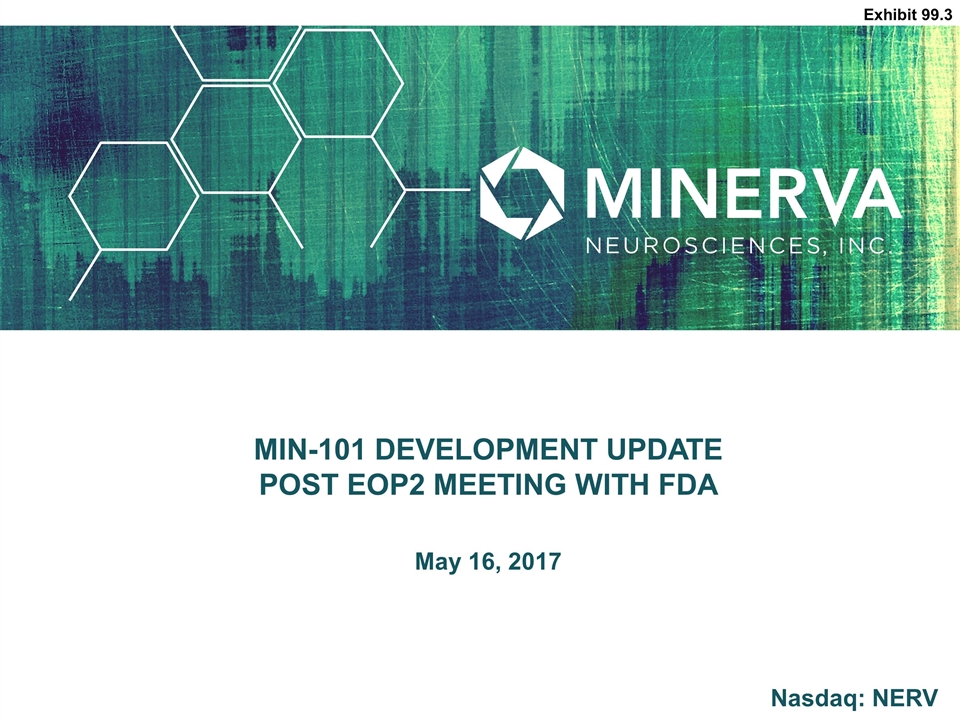
MIN-101 DEVELOPMENT UPDATE POST EOP2 MEETING WITH FDA May 16, 2017 Nasdaq: NERV Exhibit 99.3
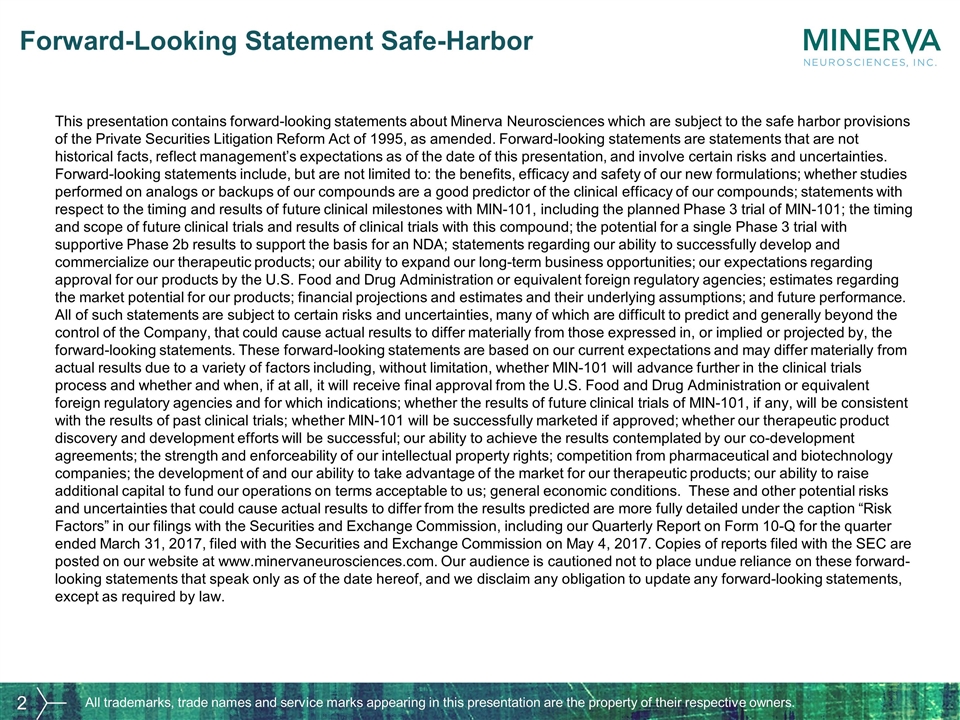
This presentation contains forward-looking statements about Minerva Neurosciences which are subject to the safe harbor provisions of the Private Securities Litigation Reform Act of 1995, as amended. Forward-looking statements are statements that are not historical facts, reflect management’s expectations as of the date of this presentation, and involve certain risks and uncertainties. Forward-looking statements include, but are not limited to: the benefits, efficacy and safety of our new formulations; whether studies performed on analogs or backups of our compounds are a good predictor of the clinical efficacy of our compounds; statements with respect to the timing and results of future clinical milestones with MIN-101, including the planned Phase 3 trial of MIN-101; the timing and scope of future clinical trials and results of clinical trials with this compound; the potential for a single Phase 3 trial with supportive Phase 2b results to support the basis for an NDA; statements regarding our ability to successfully develop and commercialize our therapeutic products; our ability to expand our long-term business opportunities; our expectations regarding approval for our products by the U.S. Food and Drug Administration or equivalent foreign regulatory agencies; estimates regarding the market potential for our products; financial projections and estimates and their underlying assumptions; and future performance. All of such statements are subject to certain risks and uncertainties, many of which are difficult to predict and generally beyond the control of the Company, that could cause actual results to differ materially from those expressed in, or implied or projected by, the forward-looking statements. These forward-looking statements are based on our current expectations and may differ materially from actual results due to a variety of factors including, without limitation, whether MIN-101 will advance further in the clinical trials process and whether and when, if at all, it will receive final approval from the U.S. Food and Drug Administration or equivalent foreign regulatory agencies and for which indications; whether the results of future clinical trials of MIN-101, if any, will be consistent with the results of past clinical trials; whether MIN-101 will be successfully marketed if approved; whether our therapeutic product discovery and development efforts will be successful; our ability to achieve the results contemplated by our co-development agreements; the strength and enforceability of our intellectual property rights; competition from pharmaceutical and biotechnology companies; the development of and our ability to take advantage of the market for our therapeutic products; our ability to raise additional capital to fund our operations on terms acceptable to us; general economic conditions. These and other potential risks and uncertainties that could cause actual results to differ from the results predicted are more fully detailed under the caption “Risk Factors” in our filings with the Securities and Exchange Commission, including our Quarterly Report on Form 10-Q for the quarter ended March 31, 2017, filed with the Securities and Exchange Commission on May 4, 2017. Copies of reports filed with the SEC are posted on our website at www.minervaneurosciences.com. Our audience is cautioned not to place undue reliance on these forward-looking statements that speak only as of the date hereof, and we disclaim any obligation to update any forward-looking statements, except as required by law. All trademarks, trade names and service marks appearing in this presentation are the property of their respective owners. Forward-Looking Statement Safe-Harbor
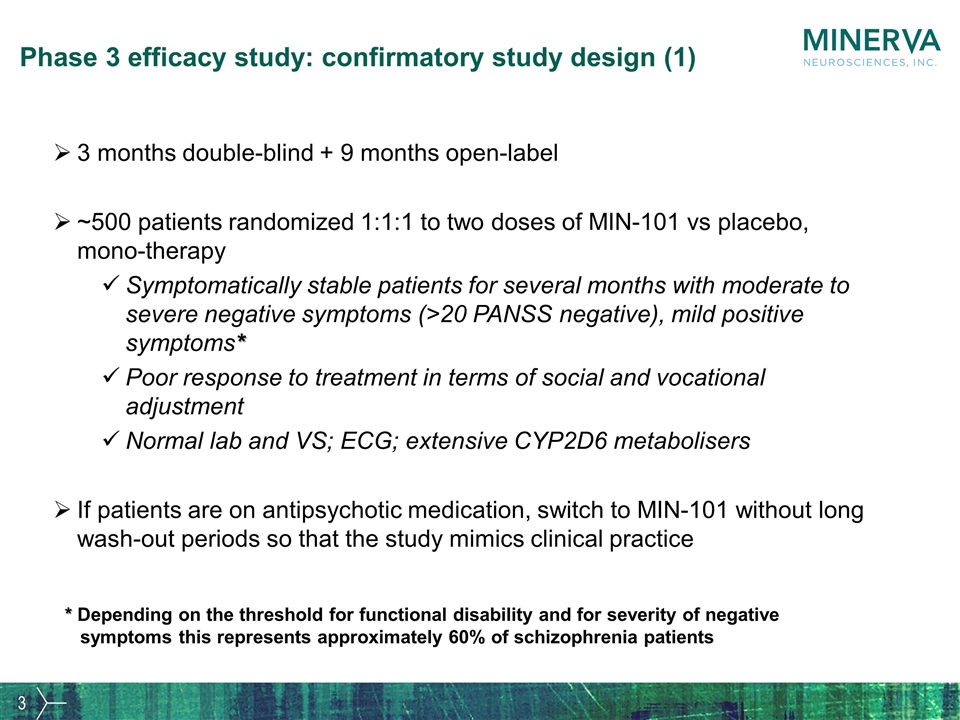
Phase 3 efficacy study: confirmatory study design (1) 3 months double-blind + 9 months open-label ~500 patients randomized 1:1:1 to two doses of MIN-101 vs placebo, mono-therapy Symptomatically stable patients for several months with moderate to severe negative symptoms (>20 PANSS negative), mild positive symptoms* Poor response to treatment in terms of social and vocational adjustment Normal lab and VS; ECG; extensive CYP2D6 metabolisers If patients are on antipsychotic medication, switch to MIN-101 without long wash-out periods so that the study mimics clinical practice * Depending on the threshold for functional disability and for severity of negative symptoms this represents approximately 60% of schizophrenia patients
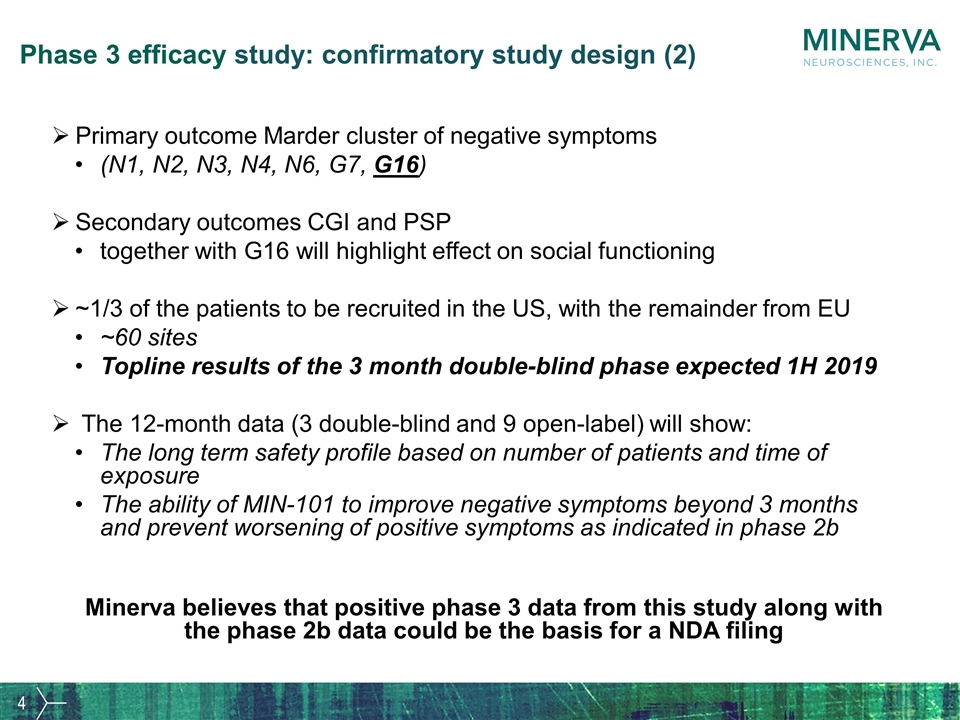
Phase 3 efficacy study: confirmatory study design (2) Primary outcome Marder cluster of negative symptoms (N1, N2, N3, N4, N6, G7, G16) Secondary outcomes CGI and PSP together with G16 will highlight effect on social functioning ~1/3 of the patients to be recruited in the US, with the remainder from EU ~60 sites Topline results of the 3 month double-blind phase expected 1H 2019 The 12-month data (3 double-blind and 9 open-label) will show: The long term safety profile based on number of patients and time of exposure The ability of MIN-101 to improve negative symptoms beyond 3 months and prevent worsening of positive symptoms as indicated in phase 2b Minerva believes that positive phase 3 data from this study along with the phase 2b data could be the basis for a NDA filing
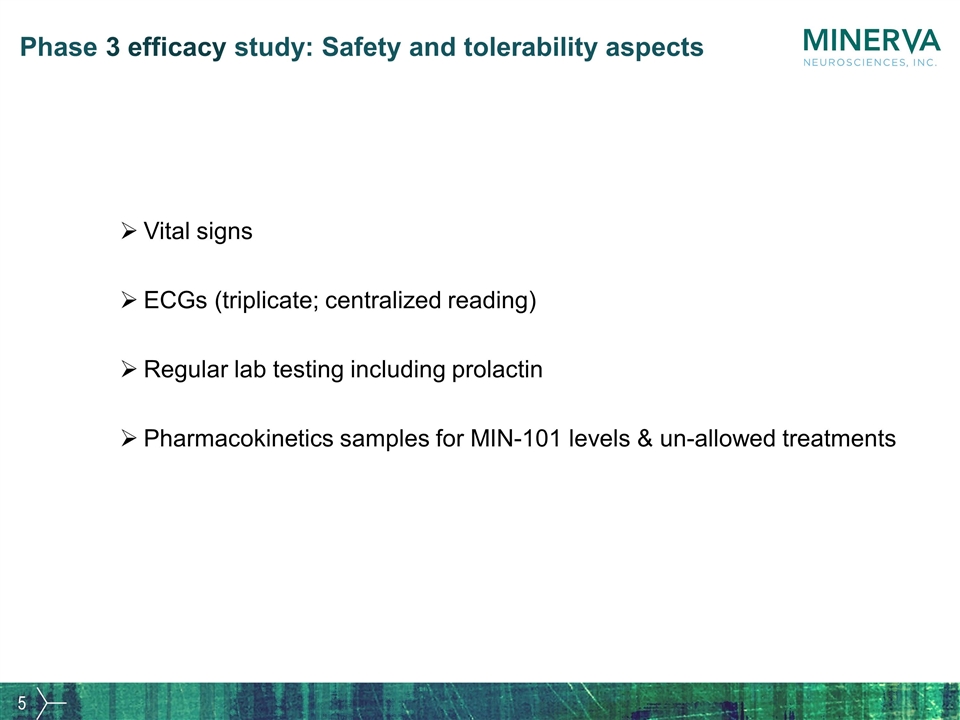
Phase 3 efficacy study: Safety and tolerability aspects Vital signs ECGs (triplicate; centralized reading) Regular lab testing including prolactin Pharmacokinetics samples for MIN-101 levels & un-allowed treatments
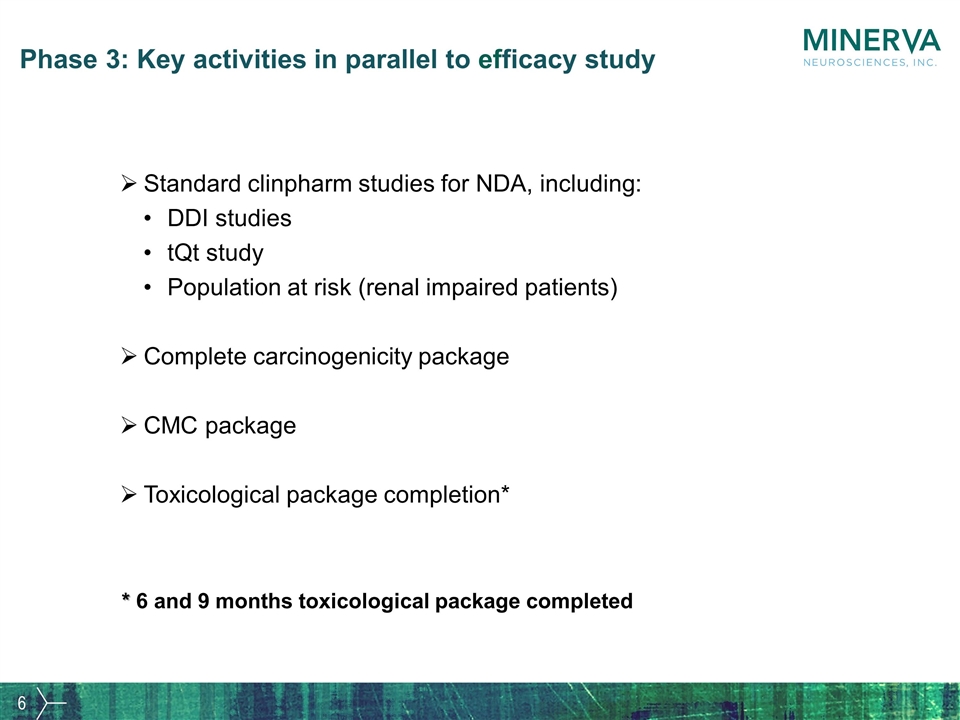
Phase 3: Key activities in parallel to efficacy study Standard clinpharm studies for NDA, including: DDI studies tQt study Population at risk (renal impaired patients) Complete carcinogenicity package CMC package Toxicological package completion* * 6 and 9 months toxicological package completed
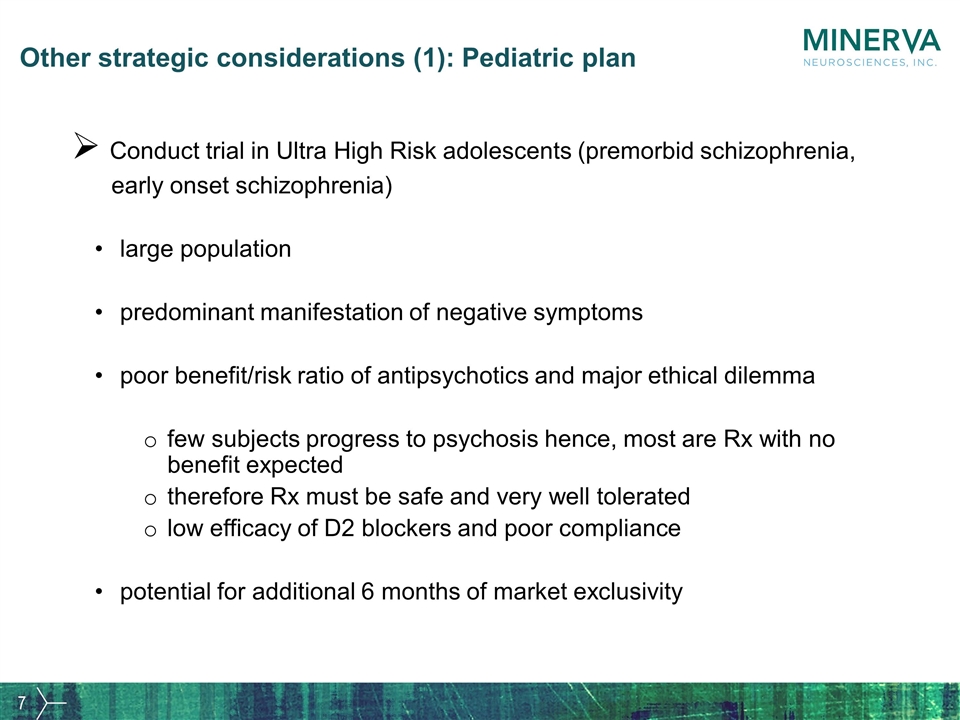
Other strategic considerations (1): Pediatric plan Conduct trial in Ultra High Risk adolescents (premorbid schizophrenia, early onset schizophrenia) large population predominant manifestation of negative symptoms poor benefit/risk ratio of antipsychotics and major ethical dilemma few subjects progress to psychosis hence, most are Rx with no benefit expected therefore Rx must be safe and very well tolerated low efficacy of D2 blockers and poor compliance potential for additional 6 months of market exclusivity
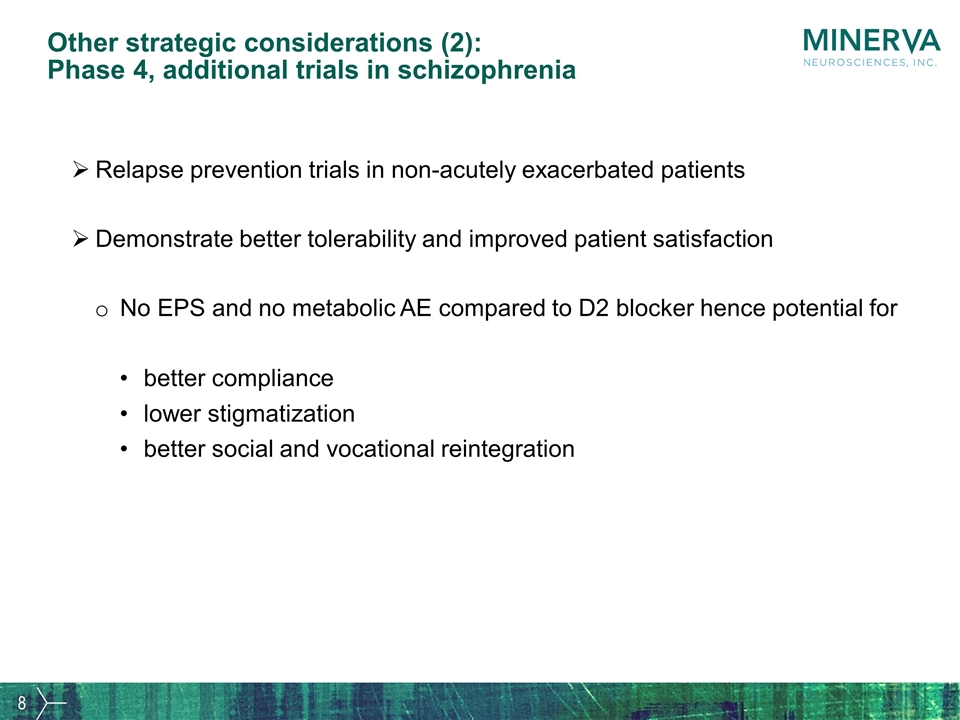
Other strategic considerations (2): Phase 4, additional trials in schizophrenia Relapse prevention trials in non-acutely exacerbated patients Demonstrate better tolerability and improved patient satisfaction No EPS and no metabolic AE compared to D2 blocker hence potential for better compliance lower stigmatization better social and vocational reintegration
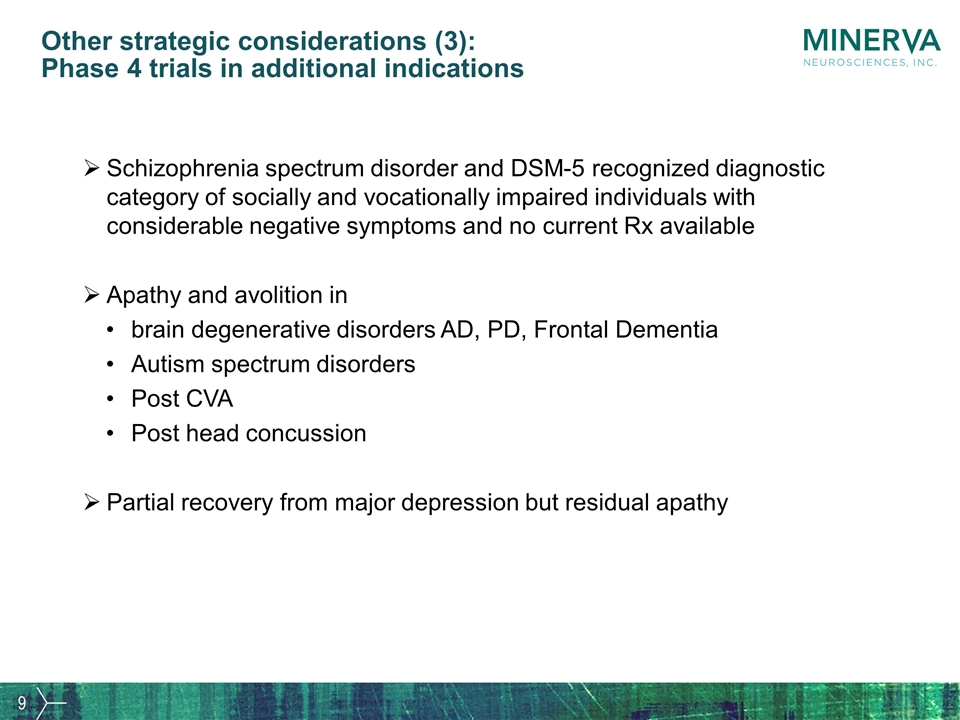
Other strategic considerations (3): Phase 4 trials in additional indications Schizophrenia spectrum disorder and DSM-5 recognized diagnostic category of socially and vocationally impaired individuals with considerable negative symptoms and no current Rx available Apathy and avolition in brain degenerative disorders AD, PD, Frontal Dementia Autism spectrum disorders Post CVA Post head concussion Partial recovery from major depression but residual apathy








